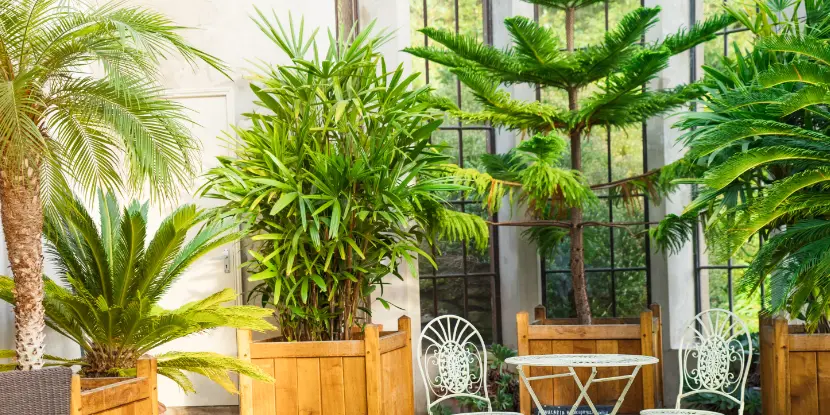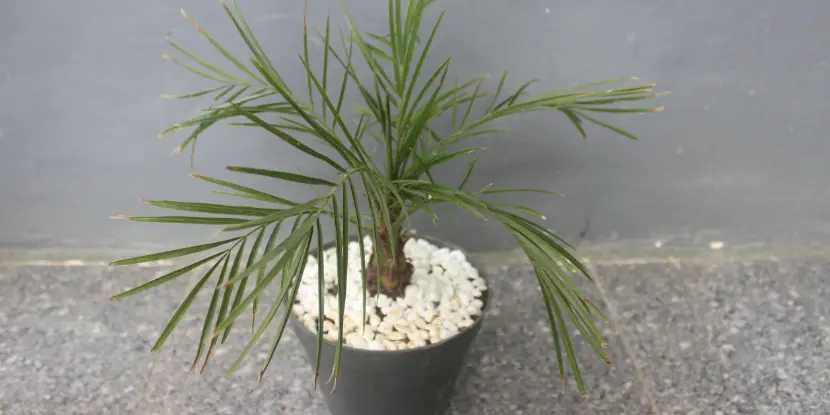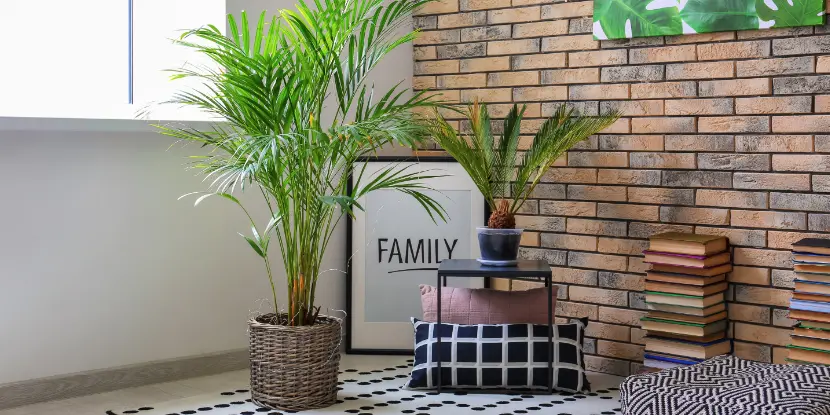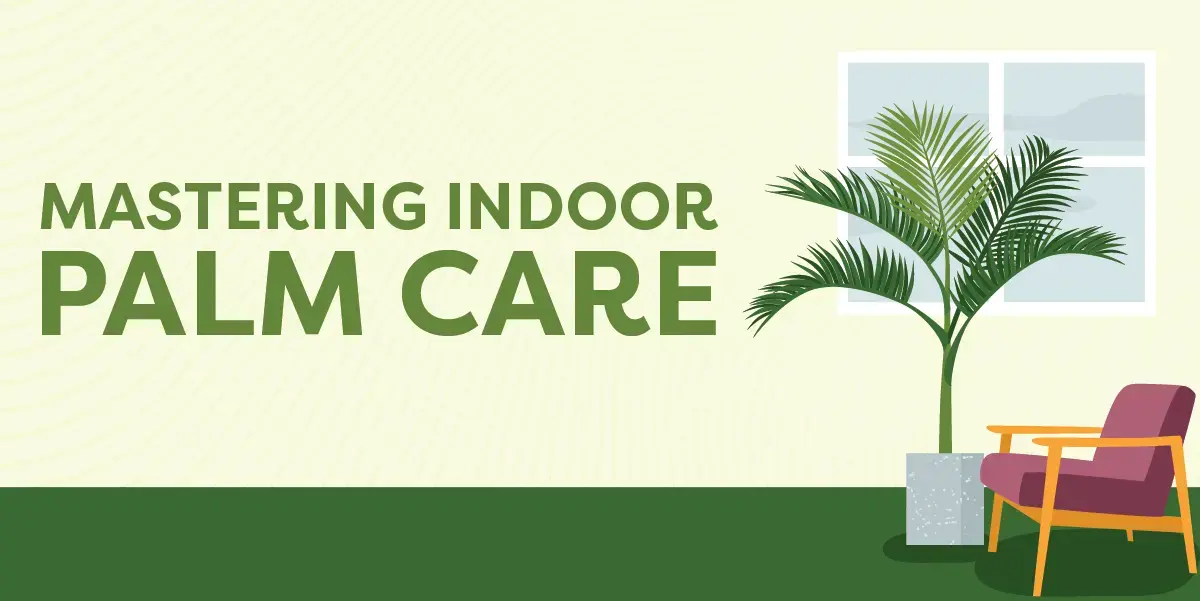Indoor palms are prized for their ability to purify the air, boost mood, and elevate decor. These tropical beauties also act as natural humidifiers, making them perfect props for dry California indoor environments.
They’re low maintenance compared to most other houseplants, needing only moderate sunlight, consistent watering, and occasional fertilization.
Still, keeping your indoor palm healthy may take more than sunlight and water. Let’s delve into the details of indoor palm care to unlock the secrets of greening your green space.
Choosing the Right Palm Tree
Most miniature palms result from careful cultivation by horticulturalists. The process of selecting smaller varieties or slower-growing species has been going on for decades.
The best varieties of indoor palm trees for California homes, and those you’re likely to find at local nurseries, include:
- Areca Palm (Dypsis lutescens): Known for its air-purifying qualities and feathery, arching fronds. It prefers bright, indirect light and moderate watering.
- Parlor Palm (Chamaedorea elegans): A compact variety ideal for smaller spaces. It thrives in low-light conditions.
- Lady Palm (Rhapis excelsa): This broad-leafed plant adapts to various indoor conditions. It requires well-drained soil and can tolerate lower light.
- Kentia Palm (Howea forsteriana): Favored for its elegant appearance and resilience. A good choice for less attentive gardeners, it favors indirect light and can survive periods of drought.
- Pygmy Date Palm (Phoenix roebelenii):This compact, exotic palm tolerates low-light conditions. It needs moist, well-drained soil.
- Majesty Palm (Ravenea rivularis):Characterized by majestic, tall fronds, this palm tree enjoys humidity and bright, indirect light. It demands more care than other palms on this list.
- Bamboo Palm (Chamaedorea seifrizii):Perfect for indoor settings due to its tolerance of shade and air-purifying properties. It does best in moist soil and can grow up to 12 feet tall.
- Sago Palm (Cycas revoluta):Though not a true palm, its appearance is palm-like. The Sago Palm is valued for its rugged, feather-like leaves. It requires less water and well-drained soil.
- Ponytail Palm (Beaucarnea recurvata): Despite its name, this isn’t a true palm, either, but shares similar care requirements. It has an unusual, swollen trunk and long, hair-like leaves, and flourishes in bright light.

Indoor palm trees in elegant wood containers.
Ideal Growing Conditions
Palms are native to tropical and subtropical regions with warm, humid conditions, nutrient-rich and well-drained soil, and plenty of indirect sunlight.
Replicating these conditions within your home goes a long way toward maintaining your plant’s health and vitality.
Repotting
When does your palm need a bigger pot? When roots begin to crowd and even protrude from drainage holes. This usually happens every two to three years but can vary depending on the palm’s growth rate and pot size.
Spring is a prime time to repot your palm, just when it’s coming out of dormancy.
- Select a container one to two inches larger in diameter than the current one. It should have adequate drainage holes to prevent waterlogging.
- Water thoroughly a day or two before repotting to reduce transplant shock.
- Use a well-draining potting mix designed for palms, or make your own by mixing general potting soil with perlite and peat moss to enhance drainage and aeration.
- Gently tilt the pot and tap it to loosen the palm. Carefully pull the plant out.
- Gently tease the roots apart if they’re densely packed. This encourages them to spread in the new pot.
- Add a layer of the soil mix to the bottom of the new pot. Center your palm and fill in around the sides with more soil mix. Ensure the palm is planted at the same depth as in its previous pot.
- Water the palm generously to settle the soil around the roots and eliminate air pockets.
- Keep the palm in a shaded area for a week before moving it to its regular spot. This helps it recover and adjust to its new environment.
Repotting is a stressful process for your palm. Be patient, as the plant may take a few weeks to recover and show new growth.

Repotting an Areca Palm.
Soil pH & Drainage
The optimal soil pH for most indoor palms ranges between 6.0 and 7.0, slightly acidic to neutral.
Measure soil with a pH meter or test kit available at garden centers or online. If the soil pH is too low (acidic), add garden lime to raise it. If it’s too high (alkaline), amend the soil with sulfur or peat moss.
Balancing soil pH is an ongoing process. Routinely testing and adjusting the soil helps maintain the right conditions for your indoor palm tree.
Watering & Humidity
Palm plants prefer a consistent watering schedule that keeps the soil evenly moist but not soggy. Overwatering can lead to root rot, while under-watering can turn the tips of leaves brown and dry.
A good rule of thumb is to water your palm when the top inch of soil feels dry. It may need more frequent watering during the warmer months when it’s in its growth phase.
In the cooler months, reduce the frequency to prevent excess moisture from accumulating in the soil.
Most household environments are drier than these tropical plants prefer. To increase humidity around your palm, you can:
- Place a humidifier nearby
- Mist the leaves regularly
- Set the pot on a tray filled with pebbles and water (the bottom of the pot should stay above the waterline)

Close-up of a beautiful Phoenix Palm bonsai in a pot.
Signs of Overwatering vs. Underwatering
- Overwatering: Leaves may yellow and become soft and mushy to the touch. You may notice a moldy or mildew smell from the soil, indicating fungal growth. In severe cases, root rot can set in, denoted by brown, black, or mushy roots, leading to the plant’s eventual decline if not addressed promptly.
- Under-watering: An under-watered palm typically exhibits dry, brown tips on its leaves, and the foliage may wilt and go limp. The soil will feel dry several inches below the surface, and leaves may curl or fold to conserve moisture.
Sunlight
Indoor palms do best in light that mimics their natural tropical and subtropical environments.
Direct sunlight, especially during the hottest parts of the day, can scorch the leaves. North or east-facing windows usually provide the gentle light palms prefer.
Too little light can lead to weak growth and sparse foliage. Artificial grow lights can substitute and provide the energy needs for photosynthesis.
Temperature Control
A temperature range of 60°F to 80°F (15°C to 27°C) aligns closely with a palm tree’s natural tropical habitat. An occasional dip below this range won’t harm mature plants, but sustained exposure to cold can stunt growth, cause leaf discoloration, and even kill more sensitive varieties.
Conversely, consistent temperatures above 80°F may stress the plant and force more frequent watering.
Palms generally have a low tolerance for drafts and sudden temperature changes. Drafty areas, particularly those near air conditioning units and cold windows, can shock and weaken the plant.
Avoid placing your palm near drafty areas and heating or cooling units.

Decorative Areca Palm in a reading room.
Day-to-Day Care
Fertilization
- Use a balanced, slow-release fertilizer designed for indoor plants or palms.
- Apply fertilizer every two months during peak growth.
- Reduce fertilizer application in the fall and halt it entirely in winter.
- Avoid over-fertilizing to prevent nutrient burn, which appears as brown tips on leaves.
- Follow the recommended dosage on the fertilizer package.
- A lighter, more frequent application is preferable to too much fertilizer at once.
Pruning
- Regularly remove dead or yellowing leaves to maintain the plant’s health and appearance.
- Use clean, sharp scissors or pruning shears to make precise cuts, which help prevent damage and disease.
- Prune during the plant’s dormant period in the early spring or late winter.
- Removing only damaged or excessive growth. Over-pruning can stunt the plant’s development.
- Cut close to the stem, but not too close to avoid damage to the trunk.
- After pruning, clean your tools with rubbing alcohol to prevent the spread of pests or diseases.

The Beaucarnea Recurvata, also known as Ponytail Palm, is not a true palm.
Pest Control
The most common and persistent pests include:
- Spider Mites: Tiny spider-like pests that cause yellow or brown spots on leaves and create delicate webs around the plant. Combat them by regularly misting your palm and wiping the leaves with a damp cloth. For severe infestations, use insecticidal soap or neem oil.
- Mealybugs: Small, white, fluffy pests that cluster in leaf axils or under leaves, sucking sap and weakening the plant. Remove by dabbing with alcohol-soaked cotton swabs or applying neem oil.
- Scale Insects: Hard or soft-bodied insects that attach to leaves and stems, causing yellowing leaves and stunted growth. Scrape them off gently with a fingernail, or use a cotton swab dipped in alcohol. For larger infestations, apply horticultural oil.
- Aphids: Small, usually green pests that suck sap from new growth, leading to distorted leaves. Blast them off with water or use soapy water, insecticidal soap, or neem oil to remove them.
- Fungus Gnats: Small black flies that buzz around soil, with larvae that feed on roots, affecting plant health. Improve drainage, allow the soil to dry between waterings, and use sticky traps to deal with the adults.
- Thrips: Tiny, slender insects that suck plant juices, causing streaking and silvering of leaves. Use insecticidal soap or neem oil, and increase humidity around your palm to deter them.
Diseases
Indoor palms are susceptible to several diseases, primarily caused by improper care or environmental conditions.
- Root Rot: This is often the result of overwatering and poor soil drainage. The symptoms include wilting, yellowing leaves, and a rotting smell from the soil. Prevention includes ensuring good drainage and allowing the soil to dry slightly between waterings.
- Leaf Spot Diseases: Caused by fungi or bacteria, these diseases manifest as dark or black spots on the leaves. Improve air circulation around the plant and water directly into the soil to prevent them.
- Powdery Mildew: A fungal disease that appears as a white powdery substance on the leaves and stems. It’s more prevalent when the air around the plant is stagnant. Ensure good air circulation and avoid overcrowding plants.
- Ganoderma: A more serious fungal disease, Ganoderma can cause leaf wilt, yellowing or browning of leaves, and trunk cracking. It’s challenging to treat, and affected plants may need to be removed to prevent the spread to other plants.
FAQs: Indoor Palm Care
Q: How often should I water my indoor palm?
Watering frequency depends on factors like humidity, temperature, and the specific palm variety. Generally, it’s best to water when the top inch of soil feels dry.
Q: Can indoor palms survive in low-light conditions?
While most indoor palms prefer bright, indirect light, some varieties, like the Cast Iron Plant and Parlor Palm, can tolerate lower light levels.
Q: Do indoor palms need a particular type of soil?
Indoor palms thrive in well-draining, loamy soil that retains moisture but doesn’t stay waterlogged. A mix of peat, sand, and perlite or bark is ideal. Avoid heavy, compact soil, as it can lead to root rot.
Q: Are indoor palms safe for pets?
While most indoor palms are non-toxic to pets, always research your specific variety and keep it out of reach of curious pets.
Q: How can I increase humidity for my indoor palm?
You can mist your palm’s leaves, place a humidifier nearby, or set the plant on a tray filled with pebbles and water. Grouping plants can also create a more humid microenvironment.
Q: What’s the best way to transplant an indoor palm?
The best time to transplant is during the spring, when the plant enters its growth phase. Choose a pot slightly larger than the current one and ensure good drainage. Carefully remove the palm, trying not to disturb the root ball, and place it in the new pot with fresh potting mix.
Q: How can I tell if my indoor palm receives too much light?
Signs of too much sun include leaves that turn yellow or brown and become crispy. If you notice these signs, move your palm to a location where it will receive bright, indirect light instead.
Q: Can I use tap water to water my indoor palm?
Tap water can sometimes contain high levels of chlorine or fluoride that can harm sensitive palms. If possible, use distilled or rainwater, or leave tap water out overnight to allow some chemicals to evaporate before watering your plant.
Q: Is it necessary to repot my indoor palm regularly?
Repotting should be done when the palm outgrows its pot, or every 2-3 years to refresh the soil. Slow growth, roots growing through drainage holes, or the soil drying out quickly after watering are indications it’s time to repot.

